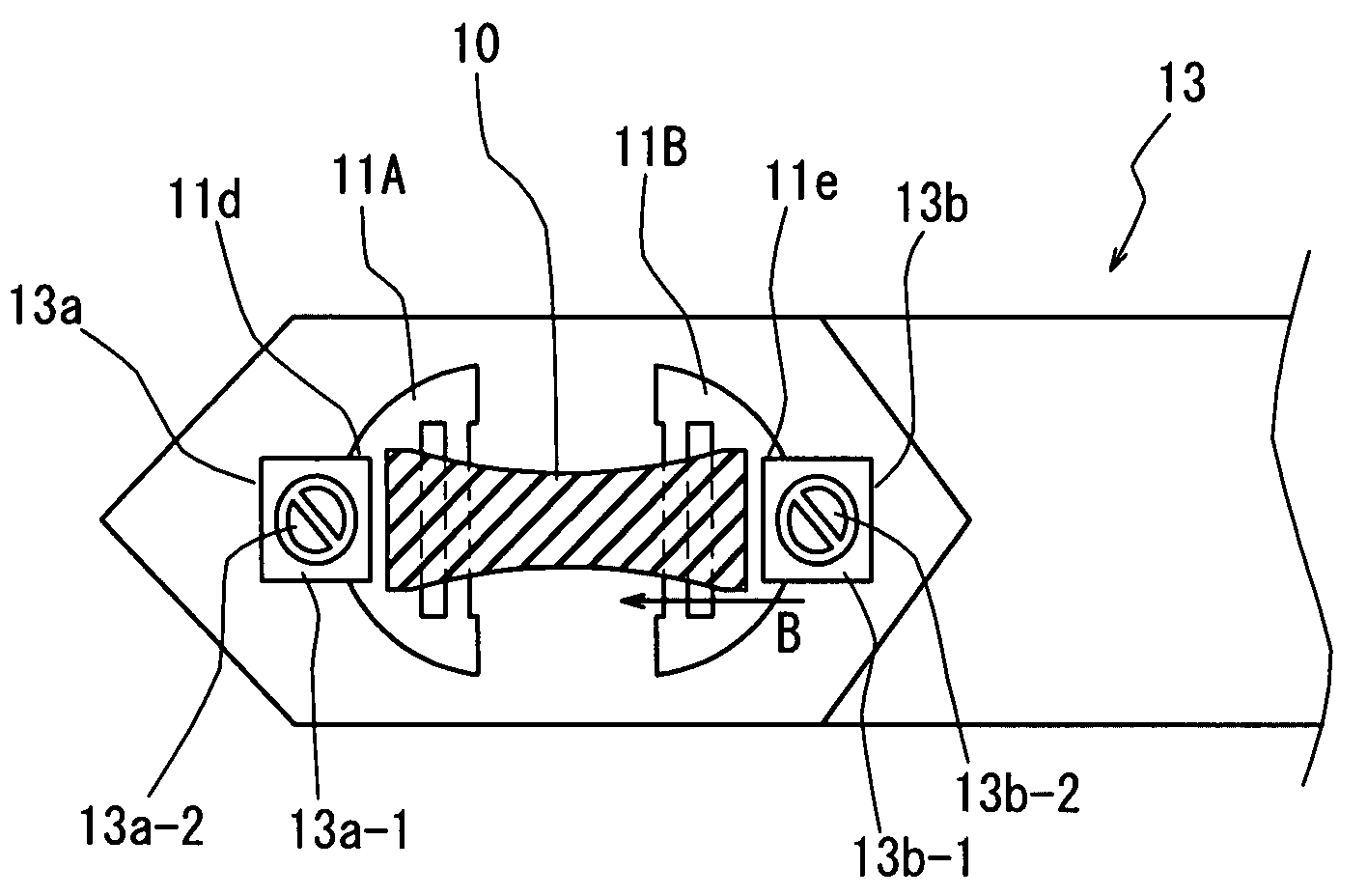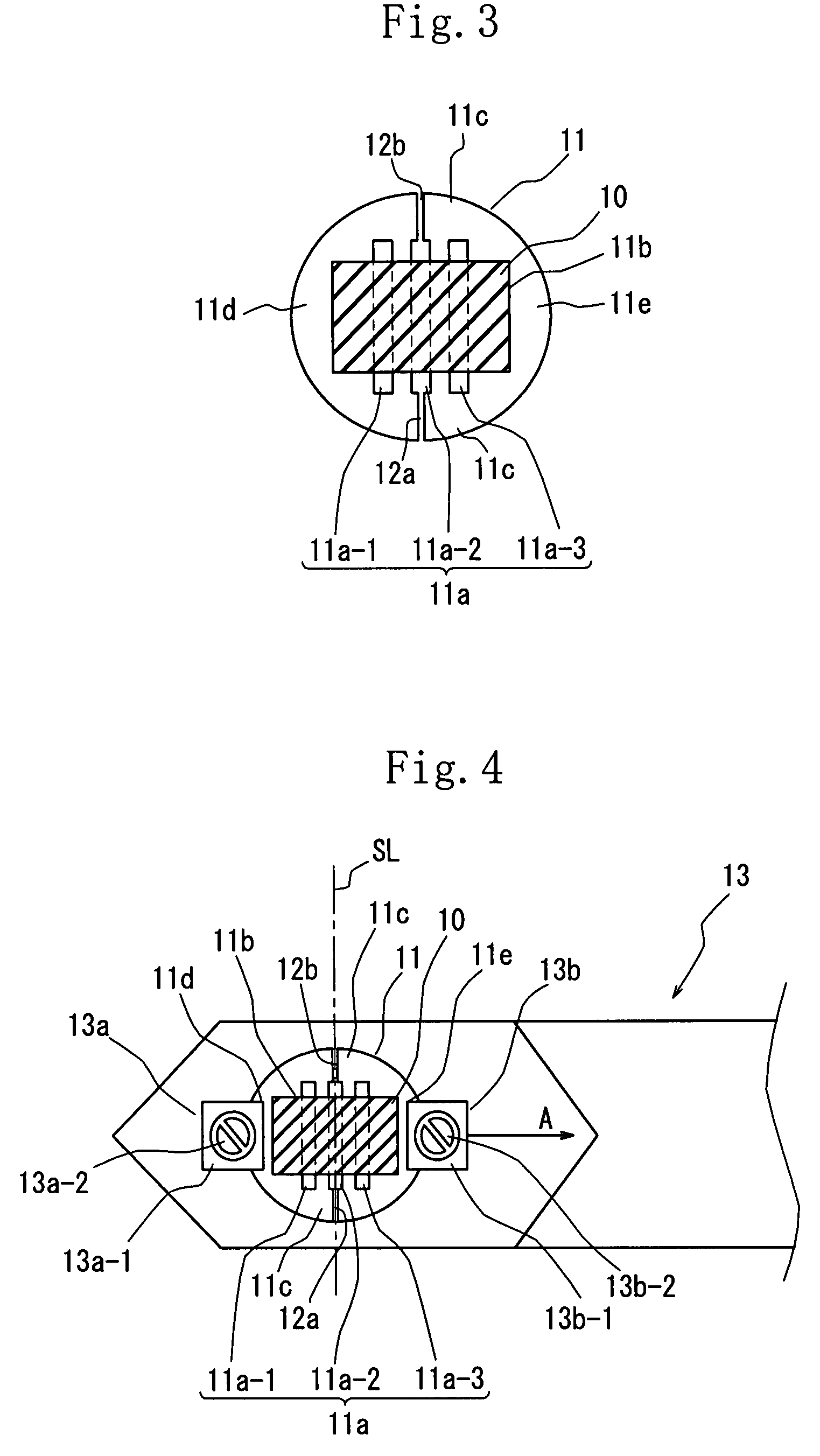Mesh and method of observing rubber slice technical field
a technology of rubber slice and mesh, which is applied in the direction of liquid/fluent solid measurement, instruments, machines/engines, etc., can solve the problems of almost impossible to stretch a conventional mesh to which the sample is fixed, and impossible to observe the rubber slice in a stretched state, etc., and achieves the effect of convenient handling of the mesh
- Summary
- Abstract
- Description
- Claims
- Application Information
AI Technical Summary
Benefits of technology
Problems solved by technology
Method used
Image
Examples
first embodiment
[0046]FIGS. 1 through 5 show the present invention.
[0047]A mesh 11 of the first embodiment has narrow groove-shaped openings 11a in a placing region 11b where a rubber slice 10 is placed and slits 12a, 12b for dividing use communicating with the narrow groove-shaped openings 11a.
[0048]That is, after the rubber slice 10 to be used as a sample shown in FIG. 2 is fixed to the mesh-placing region 11b disposed on an upper surface of the center of the mesh 11 which has three narrow groove-shaped openings 11a at the center thereof, as shown in FIGS. 3 and 4, the slits 12a, 12b for dividing use are sequentially formed on the mesh 11 by using a cutting blade (razor in the first embodiment).
[0049]Making detailed description, initially the thinned rubber slice 10 (1 mm (length)×2 mm (width)×200 nm (thickness)) is made from a rubber composition having components mixed at ratios shown in table 1 by using a microtome (not shown, commercial name: Ultramicrotome EM VC6, produced by LEICA Inc.).
[00...
second embodiment
[0071]FIG. 7 shows a
[0072]A mesh 14 of the second embodiment has one narrow groove-shaped opening 14a formed by cutting a lower side of a peripheral frame 14c. One slit 15 for dividing use is formed at an upper side of the peripheral frame 14c to form the division line SL of the narrow groove-shaped opening 14a and the slit 15 for dividing use.
[0073]After left and right sides 14d, 14e of the mesh 14 are fixed to the sample holder separation portions 13a, 13b, respectively with the rubber slice 10 fixed to the mesh 14, the slit 15 for dividing use is formed in the direction orthogonal to the stretch direction (left-to-right direction).
[0074]In the second embodiment, by the movement of the sample holder separation portion 13b in the stretch direction, the mesh 14 is divided into left and right parts, and without deforming the mesh 14, the rubber slice 10 can be stretched uniformly in the stretch direction. Therefore similarly to the first embodiment, the rubber slice 10 in the stretch...
third embodiment
[0075]FIG. 8 shows a
[0076]In a mesh 16 of the third embodiment, slits 17a, 17b, and 17c for opening use are alternately formed at upper and lower positions of a peripheral frame 16c surrounding a narrow groove-shaped opening 16a in the direction orthogonal to the stretch direction (left-to-right direction) of the rubber slice 10 to such an extent that the slits 17a, 17b, and 17c for opening use do not communicate with the narrow groove-shaped opening 16a.
[0077]The slits 17a, 17b, and 17c for opening use are formed after the left and right sides 16d, 16e of the mesh 16 are fixed to the sample holder separation portions 13a, 13b respectively with the rubber slice 10 fixed to the mesh 16. Other constructions of the third embodiment are similar to those of the first embodiment.
[0078]According to the above-described construction, the mesh 11 has the slits 17a, 17b, and 17c for opening use formed vertically and alternately on the peripheral frame 16c disposed between the left and right t...
PUM
 Login to View More
Login to View More Abstract
Description
Claims
Application Information
 Login to View More
Login to View More - R&D
- Intellectual Property
- Life Sciences
- Materials
- Tech Scout
- Unparalleled Data Quality
- Higher Quality Content
- 60% Fewer Hallucinations
Browse by: Latest US Patents, China's latest patents, Technical Efficacy Thesaurus, Application Domain, Technology Topic, Popular Technical Reports.
© 2025 PatSnap. All rights reserved.Legal|Privacy policy|Modern Slavery Act Transparency Statement|Sitemap|About US| Contact US: help@patsnap.com



